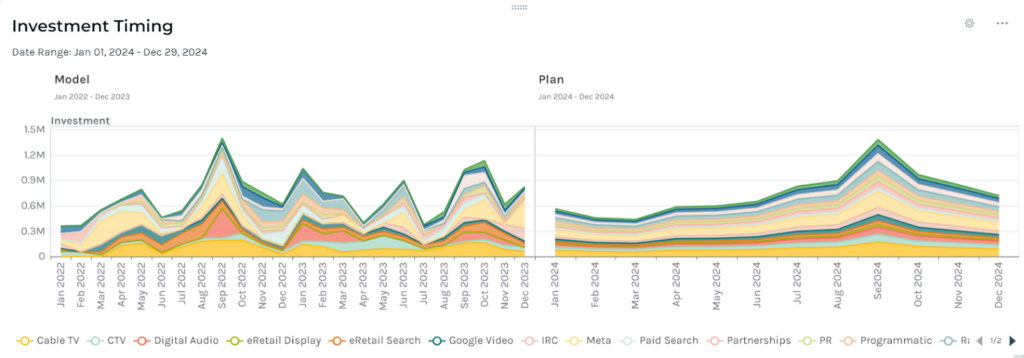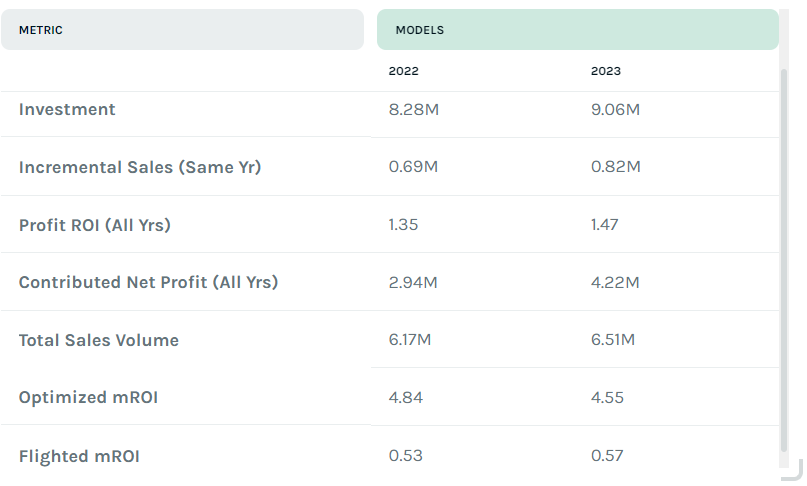The channel explosion is real: TikTok, YouTube, Google, OTT, and retail media networks. For agencies, that means more opportunities… and way more chaos, too.
You’ve got more ad platforms to show up than ever before, but no clear media plan for where to spend your budget. If your ad strategy feels scattered, cross-channel optimization is how you pull it together.
Key highlights:
- Cross-channel optimization is the technique of managing multiple ad platforms together and allocating budgets keeping the halo effect in mind.
- Cross-channel ads help you capture the modern customer who interacts with a minimum of three touchpoints before converting.
- Cross-channel campaign management starts with auditing your existing media mix strategy.
- A cross-channel marketing platform like Keen helps you see the multi-channel effects in a single place, using sophisticated machine learning and statistical techniques like Bayesian modeling.
Cross-channel optimization meaning
Cross-channel optimization is the process of managing and reallocating media budgets across multiple marketing channels to maximize total impact. It follows a big-picture advertising strategy.
A successful cross-channel campaign management requires three things:
- Knowing how your channels interact (for example, how social media drives search ads)
- Allocating budgets based on marketing incrementality, not where attribution is easiest
- Building a consistent customer journey, not fragmented campaigns
Omnichannel vs. cross-channel media planning
Many media buyers use “omnichannel marketing” and “cross-channel” interchangeably, but they serve very different purposes.
| Aspect | Cross-channel optimization | Omnichannel optimization |
| Focus | Optimize paid media spend and allocation across channels | Deliver consistent brand experience across all customer touchpoints |
| Key channels | Primarily paid media (search, display, video, OTT, retail media) | Paid, owned, and earned channels (email, web, social, in-store) |
| Marketing channel performance metrics | Incrementality, iROAS, diminishing returns, profit contribution | Engagement, retention, customer satisfaction, CLV |
| Ownership | Media buying and performance teams | CX, CRM, and marketing/brand teams |
| Tactical deliverable | Efficient media mix, optimized spend for growth and profitability | Consistent, personalized messaging and user experience |
| Example | Shift 20% of spend from display ads to YouTube based on incremental lift data, increasing total conversions | A customer receives an abandoned cart email, picks up their purchase in-store, and leaves an online review |
Why do you need a cross-channel campaign management strategy?
You need a cross-channel campaign management strategy because the gaps between your channels are costing you and your clients. The top reasons for having a cross-channel optimization strategy include:
1. Your customers don’t think in channels
According to a research report by CapitalOne, customers interact with an average of six touchpoints before they convert. They bounce between platforms. One day, they see your video ad on YouTube; the next, they Google your brand.
If your media strategy isn’t coordinated across channels, you’re wasting spend—or worse, missing out on conversions you could have captured.
2. Each media channel plays a different role, but they don’t work in isolation
Social media primes the audience. Search captures demand. Video builds it. Display nurtures it. But most agencies optimize each in a vacuum, ignoring cross-channel marketing attribution.
The result? Overfunding bottom-funnel channels (because they look good on paper) and under-investing in the upper-funnel (because it’s harder to measure). Jesse Math, from Keen, shares his experience working with agencies that fall victim to the trap of misallocation:
“If you stripped out a channel from your plan, conversions in other channels would also go away because those other channels are now less effective.”
The other channels become less effective because of the lack of the halo effect. When you’re funding one channel, the investment often lifts results in others, as well. Cross-channel optimization helps you capture this performance boost.
3. Client growth requires more than ROAS
Return on ad spend (ROAS) limitations hold back media buyers. The metric rewards the easy wins, not sustainable growth. You need to understand:
- Where your next customer is coming from
- How your channels influence each other
- Where incremental revenue is being created, not just harvested
Cross-channel optimization solves this issue, so you get a complete picture of your advertising efforts.
How to get started with cross-channel ads
Cross-media optimization isn’t just a reallocation exercise. It’s a shift in how you think about media strategy: less about what works in-platform, more about what works across the entire journey. This framework helps you move from siloed media channel planning to a connected, cross-channel strategy.
Step 1: Audit and map your current media mix for a baseline assessment
Before optimizing anything, you need a clear picture of where you are right now: your media channel mix, spend allocation, performance, and measurement limitations.
How to audit your existing media plan
- Inventory all active channels:
- Paid search (Google Ads, Bing)
- Paid social (Meta, LinkedIn, TikTok)
- Display and programmatic
- Video (YouTube, OTT, CTV)
- Retail media (Amazon, Walmart Connect)
- Affiliates
- Influencer
- Gather spend and performance data (last 6-12 months)
- Spend by channel
- Impressions, clicks, conversions (as reported by platform)
- Revenue attributed (platform and analytics tools)
- ROAS, CPA, CPL, etc.
- Assess data gaps like:
- Channels with diminishing returns (for example, search where CPAs are rising despite spend increases)
- Underfunded channels that could drive future demand (for example, video, OTT)
- Document observations to identify interaction effects:
- When upper-funnel campaigns are live, do conversion rates improve in search or direct traffic?
- Which channels are over-performing on paper but plateauing in reality?
- What channels are under-invested due to poor measurement (video, upper funnel)?
Step 2: Map the customer journey
You can’t optimize media spend across channels if you don’t understand how your customers move between them. Start by defining the real path to purchase, not the internal org chart of teams running different channels.
According to an IDC report, organizations that leverage customer journey data are three times more likely to succeed than those that don’t fully understand the buyer paths. So, take the time to map the consumer funnel based on how people interact with your client’s brand, from awareness to consideration to conversion and retention.
Action steps to map consumer path
- Break the journey into key stages:
- Awareness
- Consideration
- Conversion
- Loyalty/Retention
- Identify which channels and tactics are best suited for each stage.
- Align KPIs for each stage. Awareness isn’t about ROAS; it’s about reach, engagement, and priming demand for lower-funnel actions.
It’s important to complete all the action steps so that you can take a journey-first view, informing every optimization decision. Here’s what it looks like in practice:
| Consumer journey stage | Objective | Channels used | KPIs |
| Awareness | Create demand | YouTube, OTT, programmatic | Incremental reach, brand equity lift |
| Consideration | Nurture interest | Paid social, influencers | Engagement, CTR |
| Conversion | Capture demand | Paid search, retargeting ads | Incremental conversions, iROAS |
| Retention | Drive loyalty | Email, SMS | Repeat purchase, CLTV |
3. Implement causal measurement
Media attribution reports from Google, Meta, and Amazon only tell part of the story. They’re designed to make themselves look good. To optimize across channels, you need to know the incremental impact of each one and how much value it drives that wouldn’t have happened otherwise.
Causal measurement methods like media mix modeling (MMM) and incrementality testing give you that clarity.
Read more: What do marketing mix models show advertisers?
How to use causality in marketing
- Adopt MMM to get a holistic, top-down view of media effectiveness.
- Measure diminishing returns, channel interactions, and halo effects.
- Run scenario-based tests when launching or scaling channels, especially the upper funnel.
- Set benchmarks for:
- Incremental contribution per channel
- Diminishing returns thresholds
- Cross-channel synergy effects
Once you have the marketing causality data, you’re no longer guessing where to spend. You’re leading with evidence.
4. Reallocate budgets dynamically (and proactively)
Traditional media planning often locks budgets in place for a quarter (or longer). That’s not how cross-channel optimization works. Once you have causal impact data, you need to adjust spend in real-time, or at least on a rolling basis.
In fact, a recent study using a Bayesian approach showed that when multiple channels are quantified together in a unified model, it’s far simpler to shift spend where it drives the greatest total impact.
Read more: The benefits of Bayesian marketing mix modeling
How to plan and reallocate media spend budget
- Leverage scenario-based marketing planning:
- What happens if we shift 15% from search to YouTube?
- What’s the profit impact if we double OTT spend in Q4?
- Use incrementality data to justify reallocations—not gut feeling or internal politics.
- Start small: pilot reallocation strategies with a 10-20% shift and track incremental impact.
- Revisit and reallocate budgets on a monthly (or even weekly) cadence, not annually.

5. Unify messaging and creatives across channels
Without consistent brand messaging and creatives across different channels, you’ll lose the compounding effect of cross-channel marketing campaigns.
How to create consistent cross-channel messaging
- Use unified marketing strategies that travel across platforms.
- Example: A brand launch story that starts in video, retargets on social, and converts in search.
- Sync creative refreshes across channels to maintain momentum.
- Control frequency and sequencing to avoid overexposure.
- Make sure users aren’t seeing the same message in three different places without coordination.
- Use cross-channel audience segmentation:
- Build custom audiences based on engagement behavior, not just website visits.
Download our marketing mix modeling playbook for a step-by-step approach.
6. Measure incrementality with the latest cross-channel marketing technology
The final (and ongoing) step is to track your incremental growth and profitability. That’s how you move the conversation from media performance to business outcomes, and keep your agency positioned as a strategic advisor.
How to monitor incremental growth
Cross-channel campaign management isn’t a set-and-forget strategy. Here’s how you can keep tabs on your growth:
- Track incremental revenue and marginal ROI (mROI) at the cross-channel level.
- Monitor diminishing returns curves to know when to scale up or pull back spend.
- Report to clients in business language:
- Instead of “Conversions are up 15%,” say, “This strategy drove an incremental $500K in profit this quarter.”
- Use quarterly strategic reviews to reset goals, budgets, and forecasts, grounding your decisions in data-driven marketing, not assumptions.

Launch your cross-channel marketing campaigns with Keen
With multiple media channels to juggle, a cross-channel marketing intelligence solution helps you stay on top of it all. This is where Keen’s MMM platform comes in.
Keen for agencies moves you from siloed media buying to a true cross-channel strategy with:
- Causal measurement, not click-based guesses
- Incrementality, not platform bias
- Real-time scenario planning, so you can move budgets with confidence
- 4% margin of error forecasts, backed by $8B in media spend data
Agencies using Keen for media planning can reallocate budgets on the fly, prove long-term client value, and lead the conversation about business growth, not just media performance.
Request a demo to see how Keen can help your cross-channel optimization strategy.





